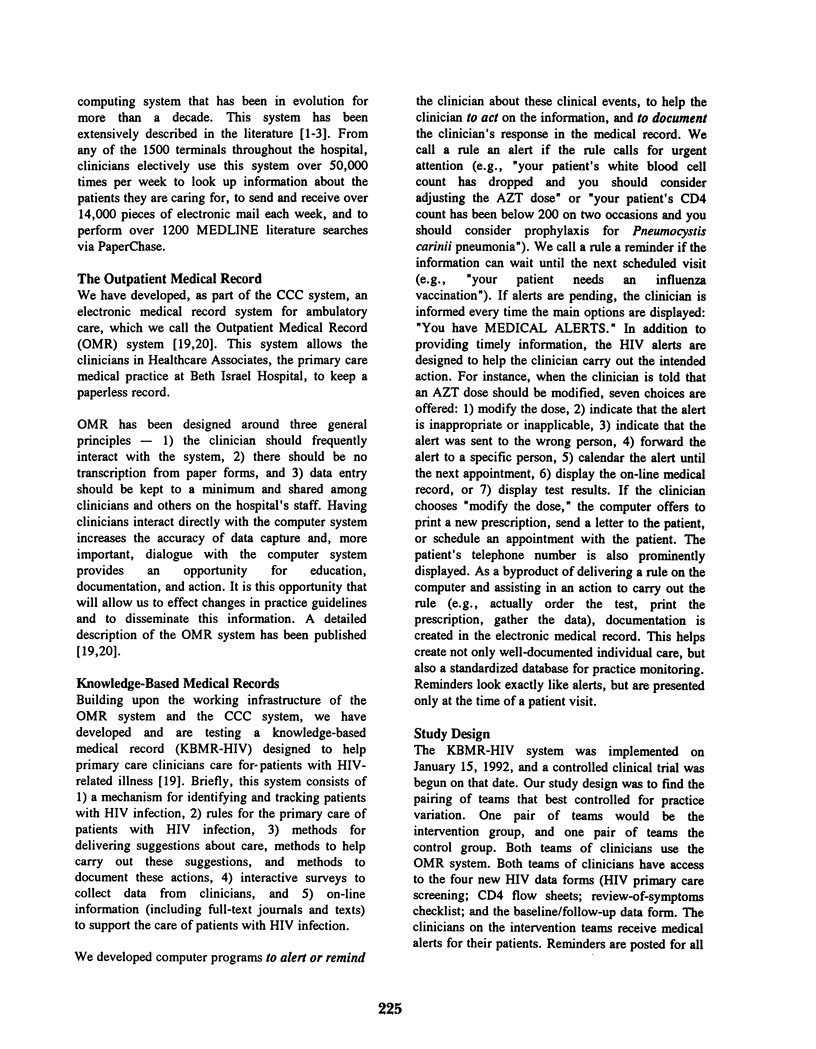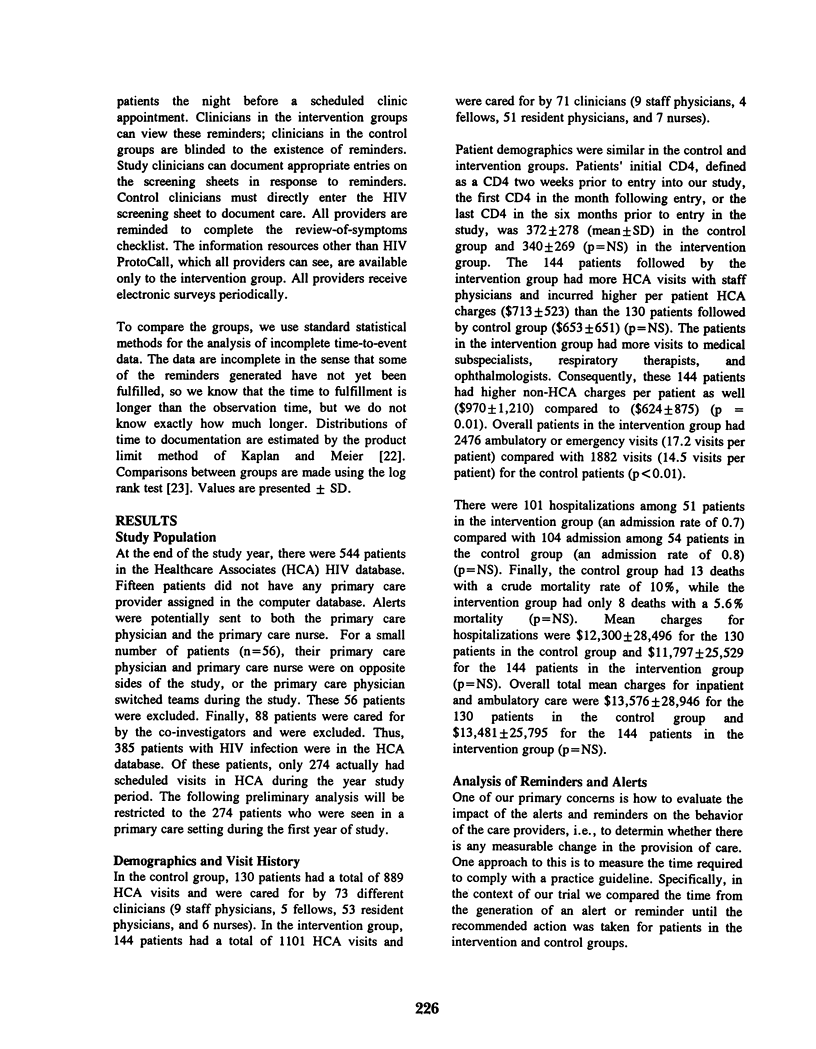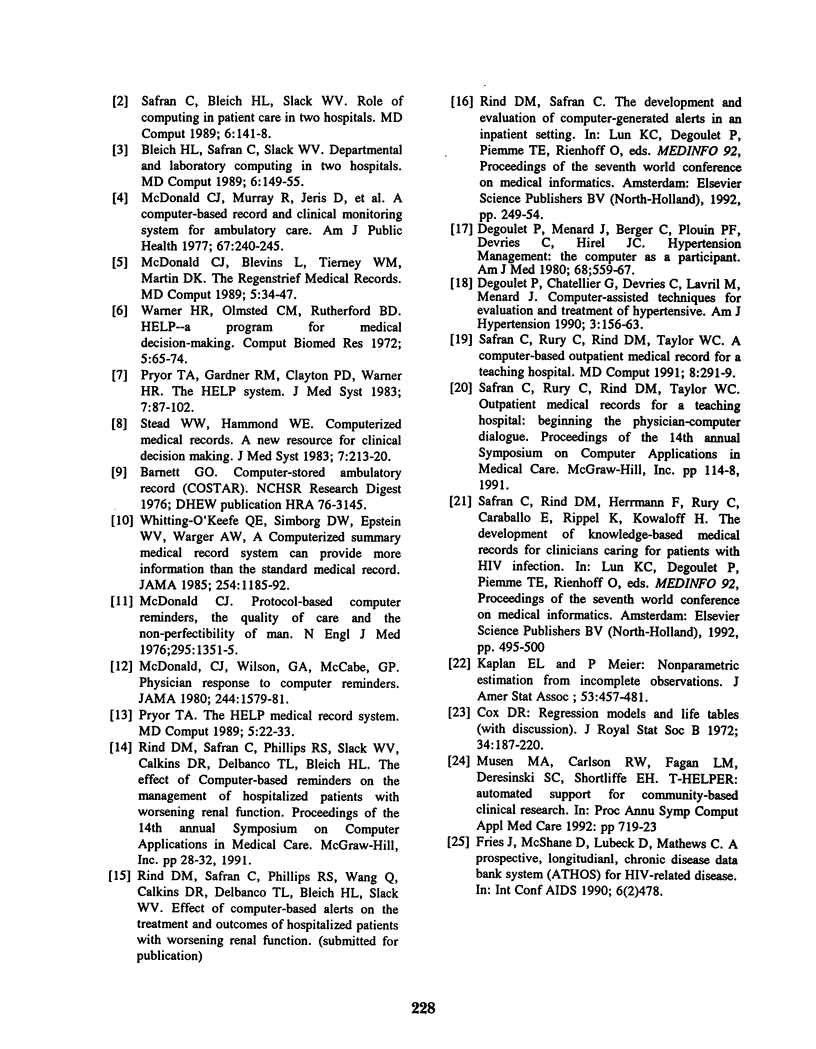Abstract
We have built a clinical workstation to help doctors and nurses care for patients with HIV infection. This knowledge-based medical record system provides medication alerts, reminders about primary care, and on-line information to support the care of patients with HIV infection. We are conducting a controlled clinical trial of this computer system in a single practice setting, which consists of 18 staff physicians, 13 nurses, and 113 residents, who cooperatively practice in four teams. Two teams of physicians are assigned to an intervention group and two teams to a control group. This paper reports preliminary results from the first year of study, January 15, 1992, through January 14, 1993. During this period 274 patients with HIV infection were followed by the general medical practice--130 in a control group and 144 in an intervention group. Physicians in the intervention group more rapidly and more completely followed primary care guidelines than did physicians in the control group. Patients in the intervention group had 2476 ambulatory or emergency visits (17.2 visits per patient) compared with 1882 visits (14.5 visits per patient) for the control patients (p < 0.01). There were 101 hospitalizations for 51 patients in the intervention group (an admission rate of 0.7) compared with 104 admissions for 54 patients in the control group (an admission rate of 0.8) (p = NS). There were 8 deaths in the intervention group (5.6%) compared with 13 (10%) in the control group (p = NS).(ABSTRACT TRUNCATED AT 250 WORDS)
Full text
PDF




Selected References
These references are in PubMed. This may not be the complete list of references from this article.
- Bleich H. L., Beckley R. F., Horowitz G. L., Jackson J. D., Moody E. S., Franklin C., Goodman S. R., McKay M. W., Pope R. A., Walden T. Clinical computing in a teaching hospital. N Engl J Med. 1985 Mar 21;312(12):756–764. doi: 10.1056/NEJM198503213121205. [DOI] [PubMed] [Google Scholar]
- Bleich H. L., Safran C., Slack W. V. Departmental and laboratory computing in two hospitals. MD Comput. 1989 May-Jun;6(3):149–155. [PubMed] [Google Scholar]
- Degoulet P., Chatellier G., Devriès C., Lavril M., Ménard J. Computer-assisted techniques for evaluation and treatment of hypertensive patients. Am J Hypertens. 1990 Feb;3(2):156–163. doi: 10.1093/ajh/3.2.156. [DOI] [PubMed] [Google Scholar]
- Degoulet P., Menard J., Berger C., Plouin P. F., Devries C., Hirel J. C. Hypertension management: the computer as a participant. Am J Med. 1980 Apr;68(4):559–567. doi: 10.1016/0002-9343(80)90306-x. [DOI] [PubMed] [Google Scholar]
- McDonald C. J., Blevins L., Tierney W. M., Martin D. K. The Regenstrief medical records. MD Comput. 1988 Sep-Oct;5(5):34–47. [PubMed] [Google Scholar]
- McDonald C. J., Murray R., Jeris D., Bhargava B., Seeger J., Blevins L. A computer-based record and clinical monitoring system for ambulatory care. Am J Public Health. 1977 Mar;67(3):240–245. doi: 10.2105/ajph.67.3.240. [DOI] [PMC free article] [PubMed] [Google Scholar]
- McDonald C. J. Protocol-based computer reminders, the quality of care and the non-perfectability of man. N Engl J Med. 1976 Dec 9;295(24):1351–1355. doi: 10.1056/NEJM197612092952405. [DOI] [PubMed] [Google Scholar]
- McDonald C. J., Wilson G. A., McCabe G. P., Jr Physician response to computer reminders. JAMA. 1980 Oct 3;244(14):1579–1581. [PubMed] [Google Scholar]
- Musen M. A., Carlson R. W., Fagan L. M., Deresinski S. C., Shortliffe E. H. T-HELPER: automated support for community-based clinical research. Proc Annu Symp Comput Appl Med Care. 1992:719–723. [PMC free article] [PubMed] [Google Scholar]
- Pryor T. A., Gardner R. M., Clayton P. D., Warner H. R. The HELP system. J Med Syst. 1983 Apr;7(2):87–102. doi: 10.1007/BF00995116. [DOI] [PubMed] [Google Scholar]
- Pryor T. A. The HELP medical record system. MD Comput. 1988 Sep-Oct;5(5):22–33. [PubMed] [Google Scholar]
- Safran C., Rury C., Rind D. M., Taylor W. C. A computer-based outpatient medical record for a teaching hospital. MD Comput. 1991 Sep-Oct;8(5):291–299. [PubMed] [Google Scholar]
- Safran C., Slack W. V., Bleich H. L. Role of computing in patient care in two hospitals. MD Comput. 1989 May-Jun;6(3):141–148. [PubMed] [Google Scholar]
- Stead W. W., Hammond W. E. Computerized medical records. A new resource for clinical decision making. J Med Syst. 1983 Jun;7(3):213–220. doi: 10.1007/BF00993282. [DOI] [PubMed] [Google Scholar]
- Warner H. R., Olmsted C. M., Rutherford B. D. HELP--a program for medical decision-making. Comput Biomed Res. 1972 Feb;5(1):65–74. doi: 10.1016/0010-4809(72)90007-9. [DOI] [PubMed] [Google Scholar]
- Whiting-O'Keefe Q. E., Simborg D. W., Epstein W. V., Warger A. A computerized summary medical record system can provide more information than the standard medical record. JAMA. 1985 Sep 6;254(9):1185–1192. [PubMed] [Google Scholar]


